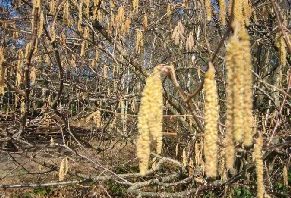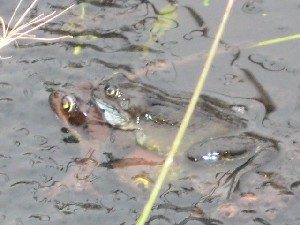
esThe tufted duck and pochard numbers will start to decrease during March, marking the end of winter, as they head back north to Russia. Pochard have been noticeably sparse again this winter with a maximum of four recorded. 21 tufted duck were recorded on the 17th. Up to 4 mandarin ducks remained on the lake during the early part of February. Hopefully some will return this month to breed. Cormorant numbers have been low with a maximum of 3 on 16th February; they are now displaying their white thigh breeding patches. Some of the black-headed gulls now have their summer plumage (black heads); their numbers will start to decrease during March. The cob swan can be seen swimming about with his wings raised and displaying with the pen. Both have been busy nestbuilding last month and it shouldn’t be long before the egg laying starts. Before then last years cygnets have to leave home and the adults have started chasing them across the lake in the hope they’ll get the hint.
The great-crested grebes usually check out suitable nest sites in March and partake in an elaborate courtship display which is worth witnessing – they raise their crests, collect waterweed and tread water whilst rising beak-to-beak. However, unfortunately we have only had one grebe present since Christmas. A little grebe has been present on the lake throughout last month and now has its summer plumage. Sixteen goosanders were recorded on 13th February and have decreased in numbers since. 95 snipe were counted leaving the marsh at dusk to feed on pasture by the Teign on 23rd February.
Our local blackbirds and starlings are already entering their breeding season, but those that are just winter visitors to Stover have first to migrate back to their breeding grounds. You can see the difference between visitors and residents by looking at their beaks. Our resident male blackbirds already have their bright golden yellow bills, but continental birds have beaks which are mostly brown. The starlings which are about to migrate have dull bills whereas those of residents are a brighter yellow. Mistle and song thrushes carried on singing during February and were joined by blackbirds on 14th February. Great-spotted woodpeckers were heard ‘drumming’ on trees to mark their territory throughout February. The smaller birds such as the tit family will start nest building this month. Tawny owls will soon be sitting on eggs if they’re not already doing so. During mild winters the first of the resident birds have young in their nests by the end of the month. There has been some interest shown in the nest boxes on warmer days and the long-tailed tits have been seen inspecting suitable nest sites in the gorse.
Look out for the aerial displays of sparrowhawks as they set up their territories over woodlands. Male woodcocks also start their territorial flights in March – at dusk they fly in circles within the woodland holding their beaks down and emitting strange whistles and croaks. Keep an eye out for the early migrant birds returning from Africa during March. Chiffchaffs, the earliest bird of passage and the bringer of Spring, will be returning from the Mediterranean and West Africa this month. However, a few overwinter in Britain so don’t automatically assume you’ve heard your first summer migrant ! Sand martins and swallows are due in any day now so keep an eye out over the Lake where they will soon be feasting on the insects.
Warm sunny days during March should bring brimstone, peacock and small tortoiseshell butterflies out of hibernation and should also activate the wood ants. The first butterfly of the year to be spotted was a brimstone on 25th February. March is a time of great activity for male weasels as they set out in search of mates. Their territorial system breaks down as the dominant males begin to range more widely. At the same time they become much more diurnal, and they are, therefore, more likely to be visible now. Pregnant vixens will be sorting out suitable earths for rearing their cubs which will be born this month. Not only will they select one in which to give birth, but also others to which they can move their cubs if disturbed. Squirrels start the year early, mating in January and February, so by now the females are ready to give birth and make special nursery dreys in the trees. The dreys are easy to see at this time of year, when the trees are still bare. On mild evenings keep an eye open for bats – they come out of hibernation whenever there is a warm spell in the winter weather and midges and other insects are about. A small number of soprano pipistrelle bats were recorded in a couple of boxes around the Reedbed area during the winter bat box checks. Most boxes were empty as the bats prefer to hibernate in places where the temperatures remain constantly cold, however the past couple of years winter bat box checks have shown that are used for hibernation. An otter was seen swimming from the island to the northern marsh at 7am on 27th February. There have been several sightings now of otters in the lake so keep an eye out if you visit early in the morning or at dusk.

March sees the start of the newt breeding season and the males should now be showing off their brightest colours. Now should be the time when reptiles generally emerge from hibernation and, as they need to warm their bodies to obtain the energy to hunt and mate, they spend a lot of time basking in the sunshine. Keep an eye out for grass-snakes in the marsh and adders on the heathland. The latter emerge from underground holes around tree roots where they’ve spent the winter. It is also peak frog-spawning time now so again keep an eye out for toads and frogs returning to their breeding ponds this month. The first frog spawn was recorded on 23rd February. During March the pike in the lake lay their eggs amongst the weeds in shallow water.